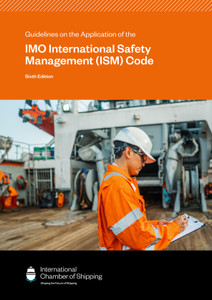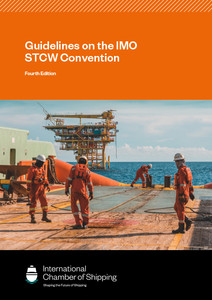
The International Convention for the Control and Management of Ships’ Ballast Water and Sediments, 2004 (BWM Convention), is concerned with preventing, minimizing and ultimately eliminating the risks to the environment, human health, property and resources arising from the transfer of harmful aquatic organisms and pathogens, through the control and management of ships’ ballast water and sediments.
This publication aims to provide an easy and comprehensive reference to the up-to-date provisions and Unified Interpretations of the Articles and Annex of the BWM Convention.
The BWM Convention also aims to avoid unwanted side-effects from that control and encourages developments in related knowledge and technology.
The 2018 consolidated edition reproduces:
- the updated text of the BWM Convention, including the incorporation of the amendments that have been adopted by the Marine Environment Protection Committee (MEPC) at its 72nd session (9 to 13 April 2018);
- the text of the Code for Approval of Ballast Water Management Systems (BWMS Code), also adopted by MEPC 72;
- four Conference resolutions adopted at the International Conference on Ballast Water Management for Ships held at IMO’s Headquarters in London from 9 to 13 February 2004;
- the up-to-date set of Guidelines for the uniform implementation of the Convention developed and adopted by MEPC, including revised versions adopted by MEPC up to its 71st session (3 to 7 July 2017); and
- other guidelines related to the implementation of the Convention.
The harmful effects of unwanted species in ships’ ballast water was first reported to IMO in 1988, when Canada informed the Marine Environment Protection Committee (MEPC) about invasive aquatic species in the Great Lakes. In response, the MEPC adopted in 1991 the first voluntary guidelines for preventing the introduction into the marine environment of unwanted aquatic organisms and pathogens from ships’ ballast waters and sediment discharges.
Following
the
UN
Conference
on
Environment
and
Development
(UNCED),
held
in
Rio
de
Janeiro
in
1992,
the
MEPC
guidelines
were
reviewed
and
adopted
as
an
Assembly
resolution
in
1993.
The
twentieth
session
of
the
IMO
Assembly
in
1997
adopted
resolution
A.868(20),
Guidelines
for
the
control
and
management
of
ships’
ballast
water
to
minimize
the
transfer
of
harmful
aquatic
organisms
and
pathogens,
which
superseded
earlier
and
less
comprehensive
guidelines.
The
new
resolution
requested
Governments
to
take
urgent
action
in
applying
the
guidelines
and
to
report
any
experience
gained
in
their
implementation
to
the
MEPC.
The
resolution
further
requested
the
MEPC
to
work
towards
the
completion
of
legally
binding
provisions
on
ballast
water
management
together
with
guidelines
for
their
uniform
and
effective
implementation.
From
1999
onwards,
the
Ballast
Water
Working
Group,
established
by
the
MEPC
in
1994,
focused
on
the
preparation
of
a
free-standing
Convention
on
control
and
management
of
ships’
ballast
water
and
sediments.
In
2002,
the
World
Summit
on
Sustainable
Development,
held
in
Johannesburg,
called
for
action
at
all
levels
to
accelerate
the
development
of
measures
to
address
invasive
alien
species
in
ballast
water.
The
introduction
of
harmful
aquatic
organisms
and
pathogens
to
new
environments
has
been
identified
as
one
of
the
four
greatest
threats
to
the
world’s
oceans
(the
other
three
being
land-sourced
marine
pollution,
overexploitation
of
living
marine
resources
and
destruction
of
habitat).
Proper
control
and
management
of
ships’
ballast
water
is
therefore
a
major
environmental
challenge
for
IMO
and
the
global
shipping
industry.
In
accordance
with
Article
2(b)
of
the
Convention
on
the
International
Maritime
Organization,
the
IMO
Council
agreed
in
principle
to
convene
a
diplomatic
conference
in
2003
to
consider
the
adoption
of
the
instrument.
At
its
eighty-ninth
session
in
November
2002,
the
Council
reconsidered
the
matter
and
approved
the
convening
of
the
Diplomatic
Conference
in
early
2004.
The
decision
of
the
Council
was
endorsed
by
the
twenty-third
session
of
the
Assembly
in
December
2003
and
the
International
Conference
on
Ballast
Water
Management
for
Ships
was
held
at
IMO’s
headquarters
in
London
from
9
to
13
February
2004.
The
Conference
adopted
the
International
Convention
for
the
Control
and
Management
of
Ships’
Ballast
Water
and
Sediments
(the
Ballast
Water
Management
Convention
or
BWM
Convention),
together
with
four
Conference
resolutions.
Several
articles
and
regulations
of
the
BWM
Convention
refer
to
guidelines
to
be
developed
by
the
Organization
and
Conference
resolution
1
invites
IMO
to
develop
these
guidelines
as
a
matter
of
urgency
and
adopt
them
as
soon
as
practicable
and,
in
any
case,
before
the
entry
into
force
of
the
Convention,
with
a
view
to
facilitate
global
and
uniform
implementation
of
the
instrument.
The
MEPC,
at
its
fifty-first
session
in
April
2004,
approved
a
programme
for
the
development
of
guidelines
and
procedures
for
uniform
implementation
of
the
BWM
Convention,
listed
in
Conference
resolution
1,
including
additional
guidance
required
but
not
listed
in
the
resolution,
which
was
further
expanded
at
the
fifty-third
session
of
the
MEPC
in
July
2005.
In
accordance
with
this
programme,
14
sets
of
Guidelines
were
developed
and
adopted
between
the
fifty-third
and
fifty-eighth
sessions
of
the
MEPC
by
October
2008,
while
subsequently
some
of
these
Guidelines
were
revised
and
additional
ones
were
also
adopted.
International Convention for the Control and Management of Ships’ Ballast Water and Sediments, 2004
Article 1 Definitions
Article 2 General obligations
Article 3 Application
Article 4 Control of the transfer of harmful aquatic organisms and pathogens through ships’ ballast water and sediments
Article 5 Sediment reception facilities
Article 6 Scientific and technical research and monitoring
Article 7 Survey and certification
Article 8 Violations
Article 9 Inspection of ships
Article 10 Detection of violations and control of ships
Article 11 Notification of control actions
Article 12 Undue delay to ships
Article 13 Technical assistance, cooperation and regional cooperation
Article 14 Communication of information
Article 15 Dispute settlement
Article 16 Relationship to international law and other agreements
Article 17 Signature, ratification, acceptance, approval and accession
Article 18 Entry into force
Article 19 Amendments
Article 20 Denunciation
Article 21 Depositary
Article 22 Languages
Annex – Regulations for the control and management of ships’ ballast water and sediments
Section A – General provisions
Regulation A-1 Definitions
Regulation A-2 General applicability
Regulation A-3 Exceptions
Regulation A-4 Exemptions
Regulation A-5 Equivalent compliance
Section B – Management and control requirements for ships
Regulation B-1 Ballast water management plan
Regulation B-2 Ballast water record book
Regulation B-3 Ballast water management for ships
Regulation B-4 Ballast water exchange
Regulation B-5 Sediment management for ships
Regulation B-6 Duties of officers and crew
Section C – Special requirements in certain areas
Regulation C-1 Additional measures
Regulation C-2 Warnings concerning ballast water uptake in certain areas and related flag State measures
Regulation C-3 Communication of information
Section D – Standards for ballast water management
Regulation D-1 Ballast water exchange standard
Regulation D-2 Ballast water performance standard
Regulation D-3 Approval requirements for ballast water management systems
Regulation D-4 Prototype ballast water treatment technologies
Regulation D-5 Review of standards by the Organization
Section E – Survey and certification requirements for ballast water management
Regulation E-1 Surveys
Regulation E-2 Issuance or endorsement of a Certificate
Regulation E-3 Issuance or endorsement of a Certificate by another Party
Regulation E-4 Form of the Certificate
Regulation E-5 Duration and validity of the Certificate
Appendices to annex
Appendix I Form of International Ballast Water Management Certificate
Appendix II Form of ballast water record book
Unified interpretation of Appendix I (Form of the International Ballast Water Management Certificate) of the BWM Convention
Code for Approval of Ballast Water Management Systems (BWMS Code)
Resolution
MEPC.300(72)
Code
for
Approval
of
Ballast
Water
Management
Systems
Resolutions adopted by the Conference
Resolution 1 Future work by the Organization pertaining to the International Convention for the Control and Management of Ships’ Ballast Water and Sediments. . .
Resolution 2 The use of decision-making tools when reviewing the standards pursuant to regulation D-5
Resolution 3 Promotion of technical cooperation and assistance
Resolution 4 Review of the Annex to the International Convention for the Control and Management of Ships’ Ballast Water and Sediments
Guidelines
for
the
uniform
implementation
of
the
Ballast
Water
Management
Convention
Resolution
MEPC.152(55)
Guidelines
for
sediment
reception
facilities
(G1)
Resolution
MEPC.173(58)
Guidelines for ballast water sampling (G2)
Part 1 Sampling from the ballast water discharge line
Part 2 Sampling from ballast water tanks
Part 3 Sampling and analysis protocols
Part 4 Sample data form
Part 5 Health and safety aspects
Part 6 Recommendation for a port State control ballast water sampling kit
Part 7 Maintenance, storage, labelling and transportation
Part 8 Chain of custody record
Resolution
MEPC.123(53)
Guidelines
for
ballast
water
management
equivalent
compliance
(G3)
Resolution
MEPC.127(53)
Guidelines
for
ballast
water
management
and
development
of
ballast
water
management
plans
(G4)
Part A Guidelines for ballast water management
Part B Guidelines for the development of ballast water management plans
Appendix Standard format for the ballast water management plan
Resolution
MEPC.153(55)
Guidelines
for
ballast
water
reception
facilities
(G5)
Resolution
MEPC.288(71)
2017
Guidelines
for
ballast
water
exchange
(G6)
Resolution
MEPC.289(71)
2017
Guidelines
for
risk
assessment
under
regulation
A-4
of
the
BWM
Convention
(G7)
Guidelines for approval of ballast water management systems (G8) is not included in this edition as it is being revoked by the BWMS Code
Resolution
MEPC.169(57)
Procedure
for
approval
of
ballast
water
management
systems
that
make
use
of
Active
Substances
(G9)
Appendix Approval scheme for Active Substances or Preparations and ballast water management systems that make use of Active Substances
Resolution
MEPC.140(54)
Guidelines
for
approval
and
oversight
of
prototype
ballast
water
treatment
technology
programmes
(G10)
Appendix Statement of compliance for a prototype ballast water treatment technology
Resolution
MEPC.149(55)
Guidelines
for
ballast
water
exchange
design
and
construction
standards
(G11)
Resolution
MEPC.209(63)
2012
Guidelines
on
design
and
construction
to
facilitate
sediment
control
on
ships
(G12)
Resolution
MEPC.161(56)
Guidelines
for
additional
measures
regarding
ballast
water
management
including
emergency
situations
(G13)
Appendix Flow chart – procedure for introducing additional measures
Resolution
MEPC.151(55)
Guidelines
on
designation
of
areas
for
ballast
water
exchange
(G14)
Other guidelines related to the implementation of the Convention
Resolution
MEPC.290(71)
The
experience-building
phase
associated
with
the
BWM
Convention
Resolution
MEPC.252(67)
Guidelines
for
port
State
control
under
the
BWM
Convention
Resolution
MEPC.228(65)
Information
reporting
on
type
approved
ballast
water
management
systems
Resolution
MEPC.206(62)
Procedure
for
approving
other
methods
of
ballast
water
management
in
accordance
with
regulation
B-3.7
of
the
BWM
Convention
Resolution
MEPC.163(56)
Guidelines
for
ballast
water
exchange
in
the
Antarctic
Treaty
area
A??s
a
specialized
agency
of
the
United
Nations,
IMO
is
the
global
standard-setting
authority
for
the
safety,
security
and
environmental
performance
of
international
shipping.
Its
main
role
is
to
create
a
regulatory
framework
for
the
shipping
industry
that
is
fair
and
effective,
universally
adopted
and
universally
implemented.
In
other
words,
its
role
is
to
create
a
level
playing
field
so
that
ship
operators
cannot
address
their
financial
issues
by
simply
cutting
corners
and
compromising
on
safety,
security
and
environmental
performance.
This
approach
also
encourages
innovation
and
efficiency.
Shipping is a truly international industry, and it can only operate effectively if the regulations and standards are themselves agreed, adopted and implemented on an international basis. IMO is the forum at which this process takes place.
- Number of Pages:
- 337
- ISBN:
- 9789280117028
- Published Date:
- November 2018
- Book Height:
- 210 mm
- Book Width:
- 150 mm
- Author:
IMO
- Preview:
- Yes
- Publication Date:
- February 2021






